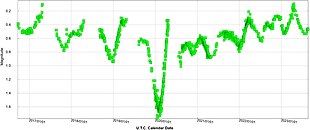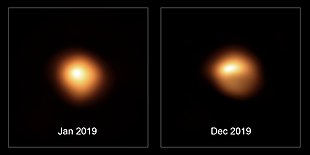1.Betelgeuse is a red supergiant star in the constellation of Orion. It is usually the tenth-brightest star in the night sky and, after Rigel, the second-brightest in its constellation. It is a distinctly reddish, semiregular variable star whose apparent magnitude, varying between +0.0 and +1.6, has the widest range displayed by any first-magnitude star. Betelgeuse is the brightest star in the night sky at near-infrared wavelengths. Its Bayer designation is α Orionis, Latinised to Alpha Orionis and abbreviated Alpha Ori or α Ori.[19]
With a radius between 640 and 764 times that of the Sun,[14][11] if it were at the center of our Solar System, its surface would lie beyond the asteroid belt and it would engulf the orbits of Mercury, Venus, Earth, and Mars. Calculations of Betelgeuse's mass range from slightly under ten to a little over twenty times that of the Sun. For various reasons, its distance has been quite difficult to measure; current best estimates are of the order of 400–600 light-years from the Sun – a comparatively wide uncertainty for a relatively nearby star. Its absolute magnitude is about −6. With an age of less than 10 million years, Betelgeuse has evolved rapidly because of its large mass, and is expected to end its evolution with a supernova explosion, most likely within 100,000 years. When Betelgeuse explodes, it will shine as bright as the half-Moon for more than three months; life on Earth will be unharmed. Having been ejected from its birthplace in the Orion OB1 association – which includes the stars in Orion's Belt – this runaway star has been observed to be moving through the interstellar medium at a speed of 30 km/s, creating a bow shock over four light-years wide.
Betelgeuse became the first extrasolar star whose photosphere's angular size was measured in 1920, and subsequent studies have reported an angular diameter (i.e., apparent size) ranging from 0.042 to 0.056 arcseconds; that range of determinations is ascribed to non-sphericity, limb darkening, pulsations and varying appearance at different wavelengths. It is also surrounded by a complex, asymmetric envelope, roughly 250 times the size of the star, caused by mass loss from the star itself. The Earth-observed angular diameter of Betelgeuse is exceeded only by those of R Doradus and the Sun.
The star's designation is α Orionis (Latinised to Alpha Orionis), given by Johann Bayer in 1603.
2.The traditional name Betelgeuse was derived from the Arabic يد الجوزاء Yad al-Jawzā’ "the hand of al-Jawzā’ [i.e. Orion]".[20][21] An error in the 13th-century reading of the Arabic initial yā’ (يـ) as bā’ (بـ—a difference in i‘jām) led to the European name.[21][22] In English, there are four common pronunciations of this name, depending on whether the first e is pronounced short or long and whether the s is pronounced /s/ or /z/:[1][2]
- /ˈbɛtəldʒuːz/ BET-əl-jooz;
- /ˈbiːtəldʒuːz/ BEE-təl-jooz;
- /ˈbɛtəldʒuːs/ BET-əl-jooss;
- /ˈbiːtəldʒuːs/ BEE-təl-jooss, popularized for sounding like "beetle juice".
In 2016, the International Astronomical Union organized a Working Group on Star Names (WGSN)[23] to catalog and standardize proper names for stars. The WGSN's first bulletin, issued July 2016,[24] included a table of the first two batches of names approved by the WGSN, which included Betelgeuse for this star. It is now so entered in the IAU Catalog of Star Names.[25]
3.Betelgeuse and its red coloration have been noted since antiquity; the classical astronomer Ptolemy described its color as ὑπόκιρρος (hypókirrhos = more or less orange-tawny), a term later described by a translator of Ulugh Beg's Zij-i Sultani as rubedo, Latin for "ruddiness".[26][a] In the 19th century, before modern systems of stellar classification, Angelo Secchi included Betelgeuse as one of the prototypes for his Class III (orange to red) stars.[27] Three centuries before Ptolemy, in contrast, Chinese astronomers observed Betelgeuse as yellow; Such an observation, if accurate, could suggest the star was in a yellow supergiant phase around this time,[28][12] a credible possibility, given current research into these stars' complex circumstellar environment.[29]
Nascent discoveries
[edit]Aboriginal groups in South Australia have shared oral tales of the variable brightness of Betelgeuse for an unknown period.[30][31]

The variation in Betelgeuse's brightness was described in 1836 by Sir John Herschel in Outlines of Astronomy. From 1836 to 1840, he noticed significant changes in magnitude when Betelgeuse outshone Rigel in October 1837 and again in November 1839.[32] A 10-year quiescent period followed; then in 1849, Herschel noted another short cycle of variability, which peaked in 1852. Later observers recorded unusually high maxima with an interval of years, but only small variations from 1957 to 1967. The records of the American Association of Variable Star Observers (AAVSO) show a maximum brightness of 0.2 in 1933 and 1942, and a minimum of 1.2, observed in 1927 and 1941.[33][34] This variability in brightness may explain why Johann Bayer, with the publication of his Uranometria in 1603, designated the star alpha, as it probably rivaled the usually brighter Rigel (beta).[35] From Arctic latitudes, Betelgeuse's red colour and higher location in the sky than Rigel meant the Inuit regarded it as brighter, and one local name was Ulluriajjuaq ("large star").[36]
In 1920, Albert A. Michelson and Francis G. Pease mounted a six-meter interferometer on the front of the 2.5-meter telescope at Mount Wilson Observatory, helped by John August Anderson. The trio measured the angular diameter of Betelgeuse at 0.047″, a figure that resulted in a diameter of 3.84×108 km (2.58 AU) based on the parallax value of 0.018″.[37] But limb darkening and measurement errors resulted in uncertainty about the accuracy of these measurements.
The 1950s and 1960s saw two developments that affected stellar convection theory in red supergiants: the Stratoscope projects and the 1958 publication of Structure and Evolution of the Stars, principally the work of Martin Schwarzschild and his colleague at Princeton University, Richard Härm.[38][39] This book disseminated ideas on how to apply computer technologies to create stellar models, while the Stratoscope projects, by taking balloon-borne telescopes above the Earth's turbulence, produced some of the finest images of solar granules and sunspots ever seen, thus confirming the existence of convection in the solar atmosphere.
4.
Imaging breakthroughs
[edit]

Astronomers saw some major advances in astronomical imaging technology in the 1970s, beginning with Antoine Labeyrie's invention of speckle interferometry, a process that significantly reduced the blurring effect caused by astronomical seeing. It increased the optical resolution of ground-based telescopes, allowing for more precise measurements of Betelgeuse's photosphere.[40][41] With improvements in infrared telescopy atop Mount Wilson, Mount Locke, and Mauna Kea in Hawaii, astrophysicists began peering into the complex circumstellar shells surrounding the supergiant,[42][43][44] causing them to suspect the presence of huge gas bubbles resulting from convection.[45] However, it was not until the late 1980s and early 1990s, when Betelgeuse became a regular target for aperture masking interferometry, that breakthroughs occurred in visible-light and infrared imaging. Pioneered by J.E. Baldwin and colleagues of the Cavendish Astrophysics Group, the new technique employed a small mask with several holes in the telescope pupil plane, converting the aperture into an ad hoc interferometric array.[46] The technique contributed some of the most accurate measurements of Betelgeuse while revealing bright spots on the star's photosphere.[47][48][49] These were the first optical and infrared images of a stellar disk other than the Sun, taken first from ground-based interferometers and later from higher-resolution observations of the COAST telescope. The "bright patches" or "hotspots" observed with these instruments appeared to corroborate a theory put forth by Schwarzschild decades earlier of massive convection cells dominating the stellar surface.[50][51]
In 1995, the Hubble Space Telescope's Faint Object Camera captured an ultraviolet image with a resolution superior to that obtained by ground-based interferometers—the first conventional-telescope image (or "direct-image" in NASA terminology) of the disk of another star.[52] Because ultraviolet light is absorbed by the Earth's atmosphere, observations at these wavelengths are best performed by space telescopes.[53] This image, like earlier pictures, contained a bright patch indicating a region in the southwestern quadrant 2,000 K hotter than the stellar surface.[54] Subsequent ultraviolet spectra taken with the Goddard High Resolution Spectrograph suggested that the hot spot was one of Betelgeuse's poles of rotation. This would give the rotational axis an inclination of about 20° to the direction of Earth, and a position angle from celestial North of about 55°.[55]
2000s studies
[edit]In a study published in December 2000, the star's diameter was measured with the Infrared Spatial Interferometer (ISI) at mid-infrared wavelengths producing a limb-darkened estimate of 55.2±0.5 mas – a figure entirely consistent with Michelson's findings eighty years earlier.[37][56] At the time of its publication, the estimated parallax from the Hipparcos mission was 7.63±1.64 mas, yielding an estimated radius for Betelgeuse of 3.6 AU. However, an infrared interferometric study published in 2009 announced that the star had shrunk by 15% since 1993 at an increasing rate without a significant diminution in magnitude.[57][58] Subsequent observations suggest that the apparent contraction may be due to shell activity in the star's extended atmosphere.[59]
In addition to the star's diameter, questions have arisen about the complex dynamics of Betelgeuse's extended atmosphere. The mass that makes up galaxies is recycled as stars are formed and destroyed, and red supergiants are major contributors, yet the process by which mass is lost remains a mystery.[60] With advances in interferometric methodologies, astronomers may be close to resolving this conundrum. Images released by the European Southern Observatory in July 2009, taken by the ground-based Very Large Telescope Interferometer (VLTI), showed a vast plume of gas extending 30 AU from the star into the surrounding atmosphere.[61] This mass ejection was equal to the distance between the Sun and Neptune and is one of multiple events occurring in Betelgeuse's surrounding atmosphere. Astronomers have identified at least six shells surrounding Betelgeuse. Solving the mystery of mass loss in the late stages of a star's evolution may reveal those factors that precipitate the explosive deaths of these stellar giants.[57]
5.
2019–2020 fading
[edit]


A pulsating semiregular variable star, Betelgeuse is subject to multiple cycles of increasing and decreasing brightness due to changes in its size and temperature.[18] The astronomers who first noted the dimming of Betelgeuse, Villanova University astronomers Richard Wasatonic and Edward Guinan, and amateur Thomas Calderwood, theorize that a coincidence of a normal 5.9 year light-cycle minimum and a deeper-than-normal 425 day period are the driving factors.[62] Other possible causes hypothesized by late 2019 were an eruption of gas or dust or fluctuations in the star's surface brightness.[63]
By August 2020, long-term and extensive studies of Betelgeuse, primarily using ultraviolet observations by the Hubble Space Telescope, had suggested that the unexpected dimming was probably caused by an immense amount of superhot material ejected into space. The material cooled and formed a dust cloud that blocked the starlight coming from about a quarter of Betelgeuse's surface. Hubble captured signs of dense, heated material moving through the star's atmosphere in September, October and November before several telescopes observed the more marked dimming in December and the first few months of 2020.[64][65][66]
By January 2020, Betelgeuse had dimmed by a factor of approximately 2.5 from magnitude 0.5 to 1.5 and was reported still fainter in February in The Astronomer's Telegram at a record minimum of +1.614, noting that the star is currently the "least luminous and coolest" in the 25 years of their studies and also calculating a decrease in radius.[67] Astronomy magazine described it as a "bizarre dimming",[68] and popular speculation inferred that this might indicate an imminent supernova.[69][70] This dropped Betelgeuse from one of the top 10 brightest stars in the sky to outside the top 20,[62] noticeably dimmer than its near neighbor Aldebaran.[63] Mainstream media reports discussed speculation that Betelgeuse might be about to explode as a supernova,[71][72][73][74] but astronomers note that the supernova is expected to occur within approximately the next 100,000 years and is thus unlikely to be imminent.[71][73]
By 17 February 2020, Betelgeuse's brightness had remained constant for about 10 days, and the star showed signs of rebrightening.[75] On 22 February 2020, Betelgeuse may have stopped dimming altogether, all but ending the dimming episode.[76] On 24 February 2020, no significant change in the infrared over the last 50 years was detected; this seemed unrelated to the recent visual fading and suggested that an impending core collapse may be unlikely.[77] Also on 24 February 2020, further studies suggested that occluding "large-grain circumstellar dust" may be the most likely explanation for the dimming of the star.[78][79] A study that uses observations at submillimetre wavelengths rules out significant contributions from dust absorption. Instead, large starspots appear to be the cause for the dimming.[80] Followup studies, reported on 31 March 2020 in The Astronomer's Telegram, found a rapid rise in the brightness of Betelgeuse.[81]
Betelgeuse is almost unobservable from the ground between May and August because it is too close to the Sun. Before entering its 2020 conjunction with the Sun, Betelgeuse had reached a brightness of +0.4 . Observations with the STEREO-A spacecraft made in June and July 2020 showed that the star had dimmed by 0.5 since the last ground-based observation in April. This is surprising, because a maximum was expected for August/September 2020, and the next minimum should occur around April 2021. However Betelgeuse's brightness is known to vary irregularly, making predictions difficult. The fading could indicate that another dimming event might occur much earlier than expected.[82] On 30 August 2020, astronomers reported the detection of a second dust cloud emitted from Betelgeuse, and associated with recent substantial dimming (a secondary minimum on 3 August) in luminosity of the star.[83]
In June 2021, the dust was explained as possibly caused by a cool patch on its photosphere[84][85][86][87] and in August a second independent group confirmed these results.[88][89] The dust is thought to have resulted from the cooling of gas ejected from the star. An August 2022[90][91][92] study using the Hubble Space Telescope confirmed previous research and suggested the dust could have been created by a surface mass ejection. It conjectured as well that the dimming could have come from a short-term minimum coinciding with a long-term minimum producing a grand minimum, a 416-day cycle and 2010 day cycle respectively, a mechanism first suggested by astronomer L. Goldberg.[93] In April 2023, astronomers reported the star reached a peak of 0.0 visual and 0.1 V-band magnitude.[94]
6.
Observation
[edit]

As a result of its distinctive orange-red color and position within Orion, Betelgeuse is easy to find with the naked eye. It is one of three stars that make up the Winter Triangle asterism, and it marks the center of the Winter Hexagon. It can be seen rising in the east at the beginning of January of each year, just after sunset. Between mid-September and mid-March (best in mid-December), it is visible to virtually every inhabited region of the globe, except in Antarctica at latitudes south of 82°. In May (moderate northern latitudes) or June (southern latitudes), the red supergiant can be seen briefly on the western horizon after sunset, reappearing again a few months later on the eastern horizon before sunrise. In the intermediate period (June–July, centered around mid June), it is invisible to the naked eye (visible only with a telescope in daylight), except around midday low in the north in Antarctic regions between 70° and 80° south latitude (during midday twilight in polar night, when the Sun is below the horizon).
Betelgeuse is a variable star whose visual magnitude ranges between 0.0 and +1.6 .[5] There are periods during which it surpasses Rigel to become the sixth brightest star, and occasionally it will become even brighter than Capella. At its faintest, Betelgeuse can fall behind Deneb and Beta Crucis, themselves both slightly variable, to be the twentieth-brightest star.[34]
Betelgeuse has a B–V color index of 1.85 – a figure which points to its pronounced "redness". The photosphere has an extended atmosphere, which displays strong lines of emission rather than absorption, a phenomenon that occurs when a star is surrounded by a thick gaseous envelope (rather than ionized). This extended gaseous atmosphere has been observed moving toward and away from Betelgeuse, depending on fluctuations in the photosphere. Betelgeuse is the brightest near-infrared source in the sky with a J band magnitude of −2.99;[95] only about 13% of the star's radiant energy is emitted as visible light. If human eyes were sensitive to radiation at all wavelengths, Betelgeuse would appear as the brightest star in the night sky.[34]

Catalogues list up to nine faint visual companions to Betelgeuse. They are at distances of about one to four arc-minutes and all are fainter than 10th magnitude.[96][97]
Star system
[edit]Betelgeuse is generally considered to be a single isolated star and a runaway star, not currently associated with any cluster or star-forming region, although its birthplace is unclear.[98]
Two spectroscopic companions to Betelgeuse have been proposed. Analysis of polarization data from 1968 through 1983 indicated a close companion with a periodic orbit of about 2.1 years, and by using speckle interferometry, the team concluded that the closer of the two companions was located at 0.06″±0.01″ (≈9 AU) from the main star with a position angle of 273°, an orbit that would potentially place it within the star's chromosphere. The more distant companion was at 0.51″±0.01″ (≈77 AU) with a position angle of 278°.[99][100] Further studies have found no evidence for these companions or have actively refuted their existence,[101] but the possibility of a close companion contributing to the overall flux has never been fully ruled out.[102] High-resolution interferometry of Betelgeuse and its vicinity, far beyond the technology of the 1980s and 1990s, has not detected any companions.[61][103]
A not yet directly-observed, dust-modulating star or white dwarf of 1.17±0.7 M☉ at a distance of 8.60±0.33 AU would be the most likely solution for Betelgeuse's 2170-day secondary periodicity, fluctuating radial velocity, moderate radius and low variation in effective temperature, as of 2024.[104]




0 Comments